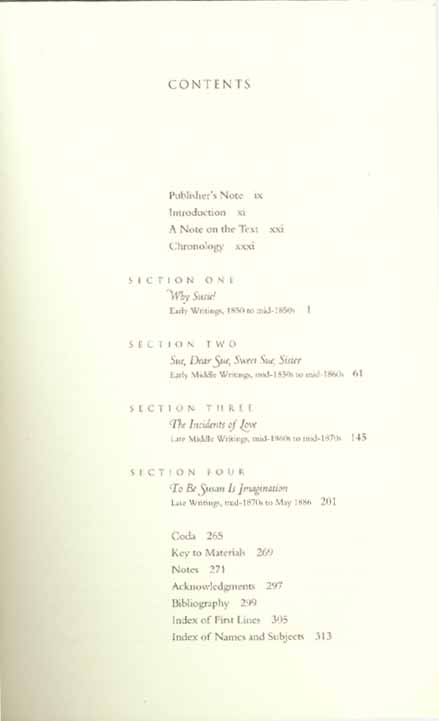


|
|
|
|
|
|
|
|
|
|
|
|
|
|
|
|
|
|
|
|
|
|
|
|
|
|
|
|
|
December 10, 1830 |
Birth of Emily Elizabeth Dickinson, daughter of Emily Norcross and Edward Dickinson, sister of Austin Dickinson (b. 1828), in Amherst, Massachusetts. |
|
December 19, 1830 |
Birth of Susan Huntington Gilbert Dickinson, daughter of Harriet Arms and Thomas Gilbert, the youngest of six children, in Deerfield, Massachusetts. |
|
1832 |
The Gilbert family moves from Deerfield to Amherst, where Thomas Gilbert becomes proprietor of the Mansion House, an inn and stagecoach stop. |
|
February 28, 1833 |
Birth of Lavinia (Vinnie) Norcross Dickinson, Emily's sister. |
|
March 1833 |
Samuel Fowler Dickinson, Emily's grandfather, sells half of the Homestead to General David Mack and moves to Ohio. |
|
late spring 1833 |
Emily lives with her aunt Lavinia Morcross in Monson, while her mother recuperates from childbirth. |
|
September 7, 1935 |
Emily begins four years at the district Primary School. |
|
February 13, 1837 |
Harriet Arms Gilbert, Susan's mother dies, of consumption. |
|
1837 |
Susan Gilbert and her sister Martha (b. 1829) move to Geneva, New York, to live with their aunt Sophia Arms Van Vranken.
|
|
|
|
late 1830s-1840s |
Susan attends Utica Female Seminary. |
|
January 1838 |
Edward Dickinson assumes his first term in the Massachusetts General Court. |
|
April 1840 |
Edward and Emily Norcross Dickinson and their three children move from the Homestead on Main Street to "the Mansion" on South Pleasant Street. |
|
September 1840 |
Emily and Lavinia Dickinson begin education at Amherst Academy. |
|
December 23, 1841 |
General Thomas Gilbert, Susan's father, dies. |
|
June 22, 1841 |
Susan's eldest sister Harriet (b. 1820) and William Cutler are married in Aschfield, Massachusetts, and move to Amherst. |
|
early 1840s-early 1850s |
Susan and Martha Gilbert live in Amherst with Harriet and William Cutler as well as in Geneva, New York. |
|
September 1847-August 1848 |
Emily attends South Hadley Female Seminary (Mount Holyoke College). |
|
fall 1847 |
Susan attends Amherst Academy for one term. |
|
1850 |
Emily sends first known letter to Susan. |
|
February 1850 |
Amherst College Indicator prints Emily's "Magnum bonum" Valentine Eve letter. |
|
September 1851-early July 1852 |
Susan teaches mathematics at Robert Archer's school in Baltimore, Maryland |
|
February 20, 1852 |
Emily's first printed poem, "A Valentine," appears in the Springfield Daily Republican. |
|
December 17, 1852 |
Edward Dickinson is elected to Congress, Representative of Tenth Massachusetts District. |
|
March 23, 1853 |
Susan Gilbert and Austin Dickinson are engaged at the Revere Hotel in Boston
|
|
|
|
|
mid-November 1855 |
The Dickinson family moves back into the renovated Homestead. |
|
July 1, 1856 |
Susan and Austin are married in the home of Susan's aunt Sophia Arms Van Vranken in Geneva , New York, then move to the Evergreens, next door to the Homestead. |
|
late 1850s |
Emily sends poems regularly to Susan; Emily begin to make her "fascicles" or manuscript books. |
|
1858-1866 |
Emily publishes eight poems in the Springfield Republican, Drum Beat, Round table, Brooklyn Daily Union, Boston Post. |
|
June 19, 1861 |
Birth of Edward (Ned) Dickinson, Susan and Austin's eldest child. |
|
April 1862 |
Thomas Wentworth Higginson's "Letter to a Young Contributor" appears as the lead article in the Atlantic Monthly. |
|
April 15, 1862 |
Emily writes to Higginson and sends four poems. |
|
April-November 1864; April-October 1865 |
Emily receives medical care from a Boston ophthalmologist and lives with cousins Fanny and Louise Norcross in Cambridgeport, Massachusetts. |
|
November 29, 1866 |
Birth of Martha (Mattie) Gilbert Dickinson, Susan and Austin's second child. |
|
spring 1872 |
Emily and Susan are seen attending church together. |
|
November 5, 1873 |
Edward Dickinson re-elected to the Massachusetts General Court. |
|
June 16,1874 |
Edward Dickinson dies. |
|
June 15, 1875 |
Emily Norcross Dickinson, Emily's mother, suffers stroke. |
|
August 1, 1875 |
Birth of Thomas Gilbert (Gib) Dickinson, Susan and Austin's youngest child.
|
|
|
|
|
February 8, 1882 |
Susan introduces Mabel Loomis Todd to Emily's poetry. |
|
November 14, 1882 |
Emily Norcross Dickinson, Emily's mother, dies. |
|
October 5, 1883 |
Gib Dickinson, Susan and Austin's youngest child, ides of typhoid fever; Susan and Emily go into seclusion. |
|
May 15, 1886 |
Emily Elizabeth Dickinson ides from Bright's disease. Susan prepares Emily's body for burial and writes the obituary that appears in the Springfield Republican. |
|
December 31, 1886 |
Susan submits "A Poem of Miss Emily Dickinson's on the 'Wind'" to The Century. |
|
August 16, 1895 |
Austin Dickinson dies. |
|
May 3, 1898 |
Ned Dickinson dies of angina. |
|
August 31, 1899 |
Lavinia Dickinson dies. |
|
May 13, 1913 |
Susan Huntington Dickinson dies. |
|
1914 |
The Single Hound: Poems of a Lifetime, edited by Martha Dickinson Bianchi, published by Little, Brown and Company.
|